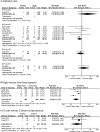Radial Artery Occlusion After Transradial Interventions: A Systematic Review and Meta-Analysis
- PMID: 26811162
- PMCID: PMC4859386
- DOI: 10.1161/JAHA.115.002686
Radial Artery Occlusion After Transradial Interventions: A Systematic Review and Meta-Analysis
Abstract
Background: Radial artery occlusion (RAO) may occur posttransradial intervention and limits the radial artery as a future access site, thus precluding its use as an arterial conduit. In this study, we investigate the incidence and factors influencing the RAO in the current literature.
Methods and results: We searched MEDLINE and EMBASE for studies of RAO in transradial access. Relevant studies were identified and data were extracted. Data were synthesized by meta-analysis, quantitative pooling, graphical representation, or by narrative synthesis. A total of 66 studies with 31 345 participants were included in the analysis. Incident RAO ranged between <1% and 33% and varied with timing of assessment of radial artery patency (incidence of RAO within 24 hours was 7.7%, which decreased to 5.5% at >1 week follow-up). The most efficacious measure in reducing RAO was higher dose of heparin, because lower doses of heparin were associated with increased RAO (risk ratio 0.36, 95% CI 0.17-0.76), whereas shorter compression times also reduced RAO (risk ratio 0.28, 95% CI 0.05-1.50). Several factors were found to be associated with RAO including age, sex, sheath size, and diameter of radial artery, but these factors were not consistent across all studies.
Conclusions: RAO is a common complication of transradial access. Maintenance of radial patency should be an integral part of all procedures undertaken through the radial approach. High-dose heparin along with shorter compression times and patent hemostasis is recommended in reducing RAO.
Keywords: radial artery occlusion; transradial catheterization or access; vascular complications.
© 2016 The Authors. Published on behalf of the American Heart Association, Inc., by Wiley Blackwell.
Figures





References
-
- Anderson SG, Ratib K, Myint PK, Keavney B, Kwok CS, Zaman A, Ludman PF, de Belder MA, Nolan J, Mamas MA. Impact of age on access site‐related outcomes in 469,983 percutaneous coronary intervention procedures: insights from the British Cardiovascular Intervention Society. Catheter Cardiovasc Interv. 2015;86:965–972. - PubMed
-
- Ratib K, Mamas MA, Anderson SG, Bhatia G, Routledge H, De Belder M, Ludman PF, Fraser D, Nolan J. Access site practice and procedural outcomes in relation to clinical presentation in 439,947 patients undergoing percutaneous coronary intervention in the United Kingdom. JACC Cardiovasc Interv. 2015;8:20–29. - PubMed
-
- Mamas MA, Anderson SG, Carr M, Ratib K, Buchan I, Sirker A, Fraser DG, Neyses L, Hildick‐Smith D, de Belder M, Ludman PF, Nolan J. Baseline bleeding risk and arterial access site practice in relation to procedural outcomes following percutaneous coronary intervention. J Am Coll Cardiol. 2014;64:1554–1564. - PubMed
-
- Ratib K, Mamas MA, Routledge HC, Ludman PF, Fraser DG, Nolan J. Influence of access site choice on incidence of neurologic complications after percutaneous coronary intervention. Am Heart J. 2013;165:317–324. - PubMed
-
- Bertrand OF, Rao SV, Pancholy S, Jolly SS, Rodés‐Cabau J, Larose E, Costerousse O, Hamon M, Mann T. Transradial approach for coronary angiography and interventions: results of the first international transradial practice survey. JACC Cardiovasc Interv. 2010;3:1022–1031. - PubMed
Publication types
MeSH terms
Substances
Grants and funding
LinkOut - more resources
Full Text Sources
Other Literature Sources
Medical

